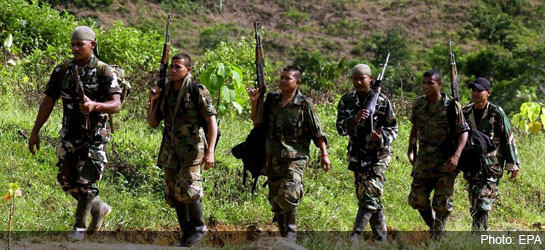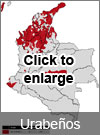
Illegal armed groups that emerged from the paramilitary AUC and the now-defunct Norte del Valle cartel have increased their presence in Colombian municipalities by 12%, according to a report by a research group.
The report by the non-governmental think tank Indepaz stated that in 2011 the illegal armed groups were largely confined to the same areas as the year before, with points of so called “BaCrim” concentration along the Caribbean and Pacific coasts and on the eastern plains.
The “Rastrojos,” formed from remnants of the Norte del Valle cartel, were the largest of the illegal armed groups with a reported presence in 247 municipalities in 23 departments, followed by the “Urabeños” with 211 municipalities in 18 departments. Colombia has 32 departments and approximately 1100 municipalities.
Indepaz noted that the expansion of the neo-paramilitary Urabeños has begun to encroach on the Rastrojos stronghold in Tumaco in the southwestern department of Nariño.
ERPAC, which officially demobilized last year, was predominetly present in eastern Colombia.
The NGO report stated that there are 207 municipalities where coca is cultivated. Despite the strong presence of Guerilla groups, a comparative breakdown of coca cultivation with the presence of “narcoparamilitaries” revealed that the principle groups to benefit from cocaine production are the Rastrojos, the Urabeños and ERPAC.
{japopup type=”image”content=”pics/2012/mphoto/rastrojos.jpg” title=”Los Rastrojos”} {/japopup}{japopup type=”image”content=”pics/2012/mphoto/urabenos.jpg” title=”Los Urabeños”}
{/japopup}{japopup type=”image”content=”pics/2012/mphoto/urabenos.jpg” title=”Los Urabeños”} {/japopup}{japopup type=”image”content=”pics/2012/mphoto/paisas.jpg” title=”Los Paisas”}
{/japopup}{japopup type=”image”content=”pics/2012/mphoto/paisas.jpg” title=”Los Paisas”} {/japopup} {japopup type=”image”content=”pics/2012/mphoto/aguilas.jpg” title=”Las Aguilas Negras”}
{/japopup} {japopup type=”image”content=”pics/2012/mphoto/aguilas.jpg” title=”Las Aguilas Negras”} {/japopup}{japopup type=”image”content=”pics/2012/mphoto/erpac.jpg” title=”ERPAC”}
{/japopup}{japopup type=”image”content=”pics/2012/mphoto/erpac.jpg” title=”ERPAC”} {/japopup}
{/japopup}


